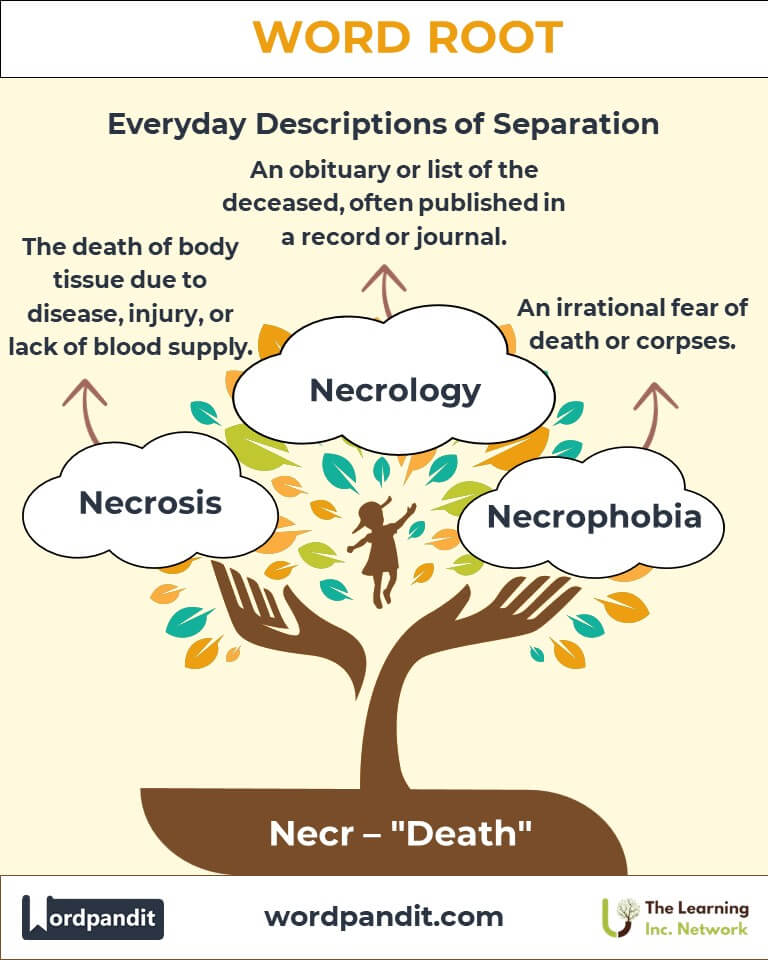Necr: The Root of Death and Its Profound Legacy
Discover the enigmatic "necr" root, derived from the Greek word "nekros," meaning "death." From the chilling concept of necromancy to the medical term necrosis, this root encapsulates humanity's fascination and fear of mortality. Explore its historical journey, cultural significance, and impact across fields like medicine, literature, and mythology.

Table of Contents
- Introduction: The Essence of "Necr"
- Etymology and Historical Journey
- Mnemonic: Unlocking the Power of "Necr"
- Common "Necr"-Related Terms
- "Necr" Through Time
- "Necr" in Specialized Fields
- Illustrative Story: "Necr" in Action
- Cultural Significance of the "Necr" Root
- The "Necr" Family Tree
- FAQs about the "Necr" Word Root
- Test Your Knowledge: "Necr" Mastery Quiz
- Conclusion: The Living Legacy of "Necr"
Introduction: The Essence of "Necr"
What images come to mind when you hear the word "necromancer"? Perhaps a dark figure conjuring spirits or delving into forbidden knowledge. The root "necr" (pronounced neh-kur) originates from the Greek "nekros," meaning death. It serves as the foundation for words that explore mortality, decay, and the afterlife. Whether in the medical field with "necrosis" or mythology with "necromancy," "necr" reveals humanity's enduring curiosity about the inevitable end.

Etymology and Historical Journey
The root "necr" traces back to the Greek "nekros," signifying death or the dead. In ancient Greece, it was often associated with rites and rituals surrounding the deceased. The term entered Latin as "necros" and spread into Old English and other European languages, evolving into words like "necropolis" (city of the dead) and "necromancy" (divination by communicating with the dead). Over centuries, "necr" has maintained its connection to death, branching into medicine, literature, and occult practices.
Mnemonic: Unlocking the Power of "Necr"
To remember "necr," picture a dark necropolis under a moonlit sky, where ancient spirits rise to tell their stories.
Mnemonic Device:
"Necr" lurks in the shadows of death, from necrosis to necromancy.
Common "Necr"-Related Terms
- Necrosis
Pronunciation: neh-kroh-sis
Definition: The death of body tissue due to disease, injury, or lack of blood supply.
Example: "Necrosis in the patient's foot required immediate surgical intervention." - Necromancer
Pronunciation: neh-kroh-man-ser
Definition: A practitioner of necromancy, often depicted as someone who communicates with the dead.
Example: "The necromancer's ritual was a central theme in the gothic novel." - Necropolis
Pronunciation: neh-kroh-puh-lis
Definition: A large, ancient cemetery or city of the dead.
Example: "The archaeologists uncovered a necropolis filled with ornate tombs." - Necrology
Pronunciation: neh-krol-uh-jee
Definition: An obituary or list of the deceased, often part of a publication.
Example: "The church published a necrology to honor community members who had passed away." - Necrophobia
Pronunciation: neh-kroh-foh-bee-uh
Definition: An irrational fear of death or corpses.
Example: "Her necrophobia made attending funerals a traumatic experience."
"Necr" Through Time
The "necr" root has evolved, reflecting cultural shifts in our understanding of death:
- Ancient Greece: Necromancy was considered a form of divination, used to consult the spirits of the dead for guidance.
- Medieval Europe: Necrology lists became common in monastic communities to memorialize the deceased.
- Modern Medicine: Necrosis became a key term in diagnosing and treating tissue death caused by diseases like diabetes or infections.
"Necr" in Specialized Fields
- Medicine: Necrosis is critical in diagnosing tissue death due to infections or trauma.
Example: "Immediate treatment prevented the spread of necrosis." - Literature: Necromancer is popular in fantasy and horror genres, symbolizing forbidden knowledge.
Example: "Tolkien's Sauron was once referred to as 'The Necromancer.'" - Archaeology: Necropolis offers insight into ancient burial practices and beliefs about the afterlife.
Example: "The necropolis at Giza houses the tombs of Egyptian pharaohs." - Psychology: Necrophobia is studied to understand anxieties surrounding mortality.
Example: "Therapists employ techniques to help patients overcome necrophobia."
Illustrative Story: "Necr" in Action
Dr. Elena Garcia, a pathologist, faced a challenging case of gangrene caused by necrosis in a patient's leg. Meanwhile, her son, Alex, read a novel featuring a daring necromancer battling spirits in a haunted necropolis. Though their worlds seemed vastly different, both grappled with the concept of death—one in science, the other in fiction.
Cultural Significance of the "Necr" Root
The "necr" root reflects humanity's deep relationship with mortality. From ancient rituals to modern medicine, it embodies our attempts to understand, honor, and sometimes fear the inevitability of death. In art and literature, "necr" fuels stories that explore the mysteries of life and the afterlife, creating a bridge between science and spirituality.

The "Necr" Family Tree
Related Roots:
- Mort (Latin: death)
- Mortal: Subject to death.
- Mortuary: A place for storing corpses.
- Thanat (Greek: death)
- Thanatology: The study of death and dying.
- Euthanasia: Painless death to relieve suffering.
- Cide (Latin: to kill)
- Homicide: The act of killing another person.
- Genocide: The deliberate killing of a large group of people.

FAQs About the "Necr" Word Root
Q: What does the root "necr" mean, and where does it come from?
A: The root "necr" comes from the Greek word "nekros," meaning "death" or "corpse." It is used in various words to describe death, decay, or the afterlife. This root has carried its meaning through centuries, influencing terms in medicine, mythology, and literature.
Q: How does necromancy differ from other spiritual practices?
A: Necromancy is specifically about communicating with or summoning the dead, often for divination or guidance. Unlike general spiritual practices that may focus on broader aspects of the soul or afterlife, necromancy has historically been viewed as a forbidden or occult art.
Q: What is necrosis, and how is it treated?
A: Necrosis refers to the death of body tissue due to factors like infection, trauma, or lack of blood supply. It is treated by addressing the underlying cause (e.g., antibiotics for infections), removing dead tissue through surgery, or in severe cases, amputating affected areas to prevent further spread.
Q: What is the significance of necropolises in archaeology?
A: Necropolises, or "cities of the dead," provide valuable insights into ancient civilizations. These burial sites often reveal cultural beliefs, burial practices, and societal hierarchies, helping archaeologists piece together historical narratives.
Q: What is the difference between necrophobia and thanatophobia?
A: Necrophobia is the irrational fear of corpses, often linked to physical reminders of death. Thanatophobia, on the other hand, is the fear of death itself or the process of dying. The former is more specific, while the latter encompasses a broader existential fear.
Test Your Knowledge: "Necr" Word Root Quiz
1. What does "necrosis" refer to?
2. What is a necromancer?
3. What is necrology?
4. What is necrophobia?
5. What does "necropolis" mean?
Conclusion: The Living Legacy of "Necr"
The "necr" root serves as a linguistic reminder of life's fragility and the human quest to understand death. Whether in medicine, mythology, or literature, "necr" continues to inspire awe, fear, and reverence. By delving into this root, we confront mortality and celebrate the enduring impact of those who came before us.












